I remember the first time I tried spirulina powder eight years ago. My friend gave me a green drink and instructed me to down it. I think it was the most disgusting thing I have ever drunk! It tasted so fishy and potent that I could barely keep it down. Fast-forward a few years. I try to take spirulina powder daily, be it by blending a small amount in a smoothie or drinking it mixed in water, as I did for the first time.
What is Spirulina?
Spirulina is a kind of microscopic algae that grows naturally in warm, alkaline water like lakes and ponds. It is a spiral-shaped, blue-green bacteria that belongs to the cyanobacteria family.
Cyanobacteria are one of the oldest life forms on Earth, existing for about 3.5 billion years. These bacteria are important because they produce oxygen through photosynthesis, which helped to create the Earth’s atmosphere. (1)(2) Not sure about you, but I find this information fascinating! Spirulina comes from one of the oldest microorganisms on our planet!
Unlike plants, spirulina doesn’t have roots, stems, or leaves. It floats freely in water and performs photosynthesis, producing its food from sunlight, carbon dioxide, and water.
Before I started researching spirulina for this article, I thought it was a regular sea plant harvested, dried and powdered. However, it is way more complicated to harvest spirulina powder. Due to its popularity, it is mainly grown in special tanks rather than ponds or lakes. So, if you want to geek out and see how spirulina is made, watch this video.
How spirulina is made :
Spirulina Benefits proven by sience
Spirulina is very high in protein—approximately 60-70% of its weight. The protein in Spirulina is highly digestible due to its lack of a tough cell wall and contains all essential amino acids(5).
Spirulina showcases many health benefits, such as:
Lowering Cholesterol:
For people with abnormal cholesterol levels, taking 1 gram of spirulina daily can significantly lower fat levels in the blood, particularly triglycerides (3).
Antidiabetic Effects:
Spirulina improves insulin sensitivity and reduces blood glucose levels in diabetic patients(4).
Fighting Cancer:
Commercial spirulina shows anti-cancer activity against lung cancer cells (6).
Immune system support :(7)(10)
"Spirulina platensis is a cyanobacterial species that is surmised to potentiate the immune system leading to suppression of cancer development and viral infection.” (11)
Brain Health
Spirulina may prevent memory loss by reducing A protein accumulation, reducing oxidative damage in mice (8)
Weight Management and Reduce Inflammation:
In overweight and obese individuals, spirulina helped reduce body weight, body fat, and appetite, while also improving triglyceride levels and reducing inflammation(12)
Mental Health and Quality of Life
“Spirulina supplementation improves anthropometric indices, blood pressure, sleep quality, mental health, fatigue status, and quality of life in patients with ulcerative colitis compared to a placebo.”(13)
Like with all supplements, spirulina has many promising benefits; however, the dosage and quality are very important. For healthy individuals, it is great to add spirulina to a daily routine to boost overall health and get exceptional nutrition.
Green Vs Blue Spirulina
Regular green and blue spirulina are derived from the same type of cyanobacteria but differ in composition. Blue spirulina is an extract from regular spirulina. The extraction process isolates the pigment phycocyanin, responsible for its bright blue colour.
Blue Spirulina doesn’t contain the whole range of nutrients but has five times more phycocyanin than regular green spirulina.
Phycocyanin is a water-soluble pigment-protein complex that is a powerful antioxidant and anti-inflammatory compound. It scavenges free radicals and prevents oxidative damage to cells (5).
Phycocyanin is linked to various health benefits, including supporting liver health, improving energy levels, and reducing inflammation. It is also a very potent antioxidant.
Here is a table of nutrients, vitamins, minerals, antioxidants, and pigments per 10 grams of spirulina to compare the regular green and blue spirulina nutritional profiles.
Green regular vs Blue Spirulina nutrition comparison table:
| Nutrient/Component | Regular Spirulina (per 10g) | Blue Spirulina (per 10g) |
|---|---|---|
| Calories | 40 | 20 |
| Protein | 6.0g | 0.5g |
| Total Fat | 1.0g | 0.1g |
| Carbohydrates | 2.5g | 0.5g |
| Fiber | 0.4g | 0.1g |
| Vitamins | ||
| Vitamin A | 290 IU | 0 IU |
| Vitamin B1 (Thiamine) | 0.3mg (20% DV) | 0.02mg |
| Vitamin B2 (Riboflavin) | 0.35mg (20% DV) | 0.01mg |
| Vitamin B3 (Niacin) | 1.3mg (7% DV) | 0.05mg |
| Vitamin B6 | 0.1mg (5% DV) | 0.005mg |
| Vitamin B12 | 0.003mg (13% DV) | 0.0002mg |
| Vitamin C | 1.5mg (2% DV) | 0mg |
| Vitamin E | 0.9mg (5% DV) | 0.05mg |
| Vitamin K | 0.02mg (25% DV) | 0mg |
| Minerals | ||
| Calcium | 20mg (2% DV) | 1mg |
| Iron | 2.0mg (25% DV) | 0.1mg |
| Magnesium | 15mg (4% DV) | 1mg |
| Phosphorus | 50mg (5% DV) | 2mg |
| Potassium | 95mg (3% DV) | 10mg |
| Sodium | 70mg | 1mg |
| Zinc | 0.2mg (2% DV) | 0.01mg |
| Antioxidants and Pigments | ||
| Chlorophyll | 0.3g | Trace amounts |
| Phycocyanin | 1.5g | 5.0g |
| Beta-carotene | 4.0mg | Trace amounts |
| Zeaxanthin | 2.0mg | Trace amounts |
| Other Elements | ||
| Essential Fatty Acids | 0.1g | Trace amounts |
| Gamma-linolenic acid (GLA) | 0.03g | Trace amounts |
Green vs Blue Spirulina Takeaways:
Regular green spirulina is more nutrient-dense and contains a broader range of vitamins, minerals, and proteins. It is an excellent source of vitamins B1, B2, B12 and Iron, which are beneficial, especially if you are on a plant-based diet.
Blue spirulina is valued for its high phycocyanin content.
Where to buy Spirulina?
Like all supplements and superfoods, you need to buy Spirulina from trusted brands to ensure it is not contaminated with potentially pathogenic bacteria (9). Contamination is more likely for spirulina grown in open ponds rather than closed, sterile environments.
- Make sure you buy from the brand you trust.
- Check where spirulina was grown to ensure that this country has good food quality standards. Ideally, it should state that spirulina was grown in a controlled environment like a tank rather than an open pond, where there is much more risk for contamination.
- Try to buy organic/ tested for heavy metals spirulina.
- I recommend buying pure spirulina powder rather than tables or capsules to avoid unnecessary filler ingredients.
- Check the expiry date to make sure it is fresh.
I found a few good few examples of good-quality spirulina powder online:
1. Terrasoul Superfoods, Spirulina Powder
I like this spirulina as it is organically certified. It also specifies that it is grown in a tank, away from industrial areas.
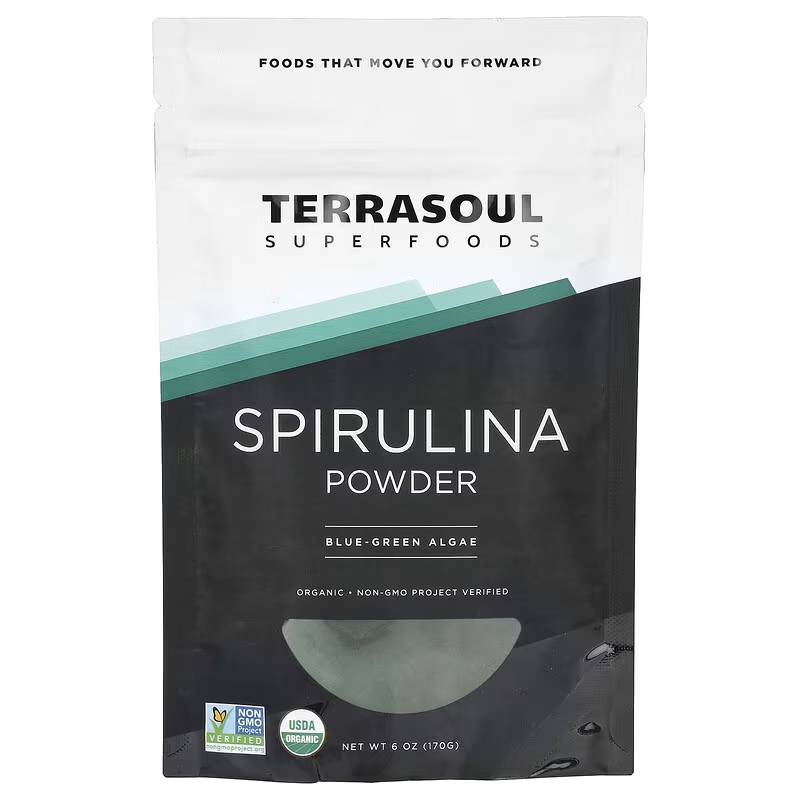
2. Triquetra Health Organic Spirulina Powder
This organic spirulina powder has many certifications and third-party tests and also identifies the exact spirulina farmer.
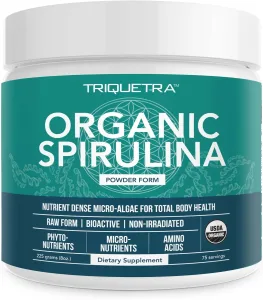
3. Pure Hawaiian Spirulina Powder Natural Premium Spirulina
Grown and bottled in the USA, you can be confident knowing where your spirulina comes from, a USA GMP-certified facility with extensive quality control & lab testing of every batch.
How does spirulina taste, and how can it be used?
The regular green spirulina has a very distinct and strong taste. Some say it tastes earthy and grassy, while others describe it as algae-like. Blue spirulina has a much milder flavour than regular spirulina and can be added to food and drinks without altering the taste too much.
If you use spirulina powder, start with small quantities, see how you like the taste, and slowly increase the dose. Try to pair it with strong flavours so you don’t feel the taste that much. Ensure it is blended well to avoid spirulina powder clumps that are unpleasant to eat.
Add green and blue spirulina to smoothies, juices and smoothie bowls.
You can also add green spirulina to salad dressings, soups and stews.
Blue spirulina is used in backing for its unique blue colour without altering the taste too much. You can add it to muffins, cookies, and energy bars. Or use blue spirulina as a decoration blue colour in cheesecakes.

If you love learning about superfoods, read:
BENEFITS OF IRISH SEA MOSS. A DEEP DIVE INTO THE SUPERFOOD
MICROGREENS – BENEFITS, NUTRITION & HOW TO GROW THEM
20 AFFORDABLE SUPERFOODS & THEIR SCIENCE-PROVED BENEFITS
Conclusion
When deciding between grren and blue spirulina, you need to remember that the regular green spirulina has way more to offer nutrition-wise than the blue spirulina, which is mainly a phycocyanin extract and lacks any other vitamins and minerals. In essence, green spirulina is the better option if you’re looking for a comprehensive nutritional supplement. Blue spirulina is ideal for natural food colouring with specific antioxidant benefits.
Spirulina is an amazing addition to your daily nutrition, but it is important to remember that consuming spirulina each day is very beneficial for your health. However it will not cancel out unhealthy diet and lifestyle.
Please Note: This post is for informational purposes only and is based on research. It’s not medical advice. It’s always best to consult a healthcare professional with health concerns. Enjoy reading!
This post contains affiliate links, and I may earn a small commission if you buy through them at no extra cost to you. For more details, please check out my Affiliate Disclosure.
- Spirulina comes from cyanobacteria family https://ucmp.berkeley.edu/bacteria/cyanolh.html
- Mehdizadeh Allaf, M., & Peerhossaini, H. (2022). Cyanobacteria: Model Microorganisms and Beyond. Microorganisms, 10(4), 696. https://doi.org/10.3390/microorganisms10040696
- Mazokopakis, E., Starakis, I., Papadomanolaki, M., Mavroeidi, N., & Ganotakis, E. (2014). The hypolipidaemic effects of Spirulina (Arthrospira platensis) supplementation in a Cretan population: a prospective study.. Journal of the science of food and agriculture, 94 3, 432-7 . https://doi.org/10.1002/jsfa.6261.
- El-Sakhawy, M. A., Iqbal, M. Z., Gabr, G. A., Alqasem, A. A., Ateya, A. A. E.-S., Ahmed, F. A., El-Hashash, S. A., Ibrahim, H. S., & Abu El-Ghiet, U. M. (2023). The mechanism of action of Spirulina as antidiabetic: a narrative review. Italian Journal of Medicine, 17(2). https://doi.org/10.4081/itjm.2023.1639
- Capelli, Bob & Cysewski, Gerald. (2010). Potential health benefits of spirulina microalgae*. Nutrafoods. 9. 10.1007/BF03223332. https://www.researchgate.net/publication/257276871_Potential_health_benefits_of_spirulina_microalgae
- Czerwonka, A., Kaławaj, K., Sławińska-Brych, A., Lemieszek, M., Bartnik, M., Wojtanowski, K., Zdzisińska, B., & Rzeski, W. (2018). Anticancer effect of the water extract of a commercial Spirulina (Arthrospira platensis) product on the human lung cancer A549 cell line.. Biomedicine & pharmacotherapy = Biomedecine & pharmacotherapie, 106, 292-302 . https://doi.org/10.1016/j.biopha.2018.06.116.
- Mao, T., Water, J., & Gershwin, M. (2005). Effects of a Spirulina-based dietary supplement on cytokine production from allergic rhinitis patients.. Journal of medicinal food, 8 1, 27-30 . https://doi.org/10.1089/JMF.2005.8.27.
- Hwang, J., Lee, I., Jeng, K., Wang, M., Hou, R., Wu, S., & Chan, Y. (2011). Spirulina prevents memory dysfunction, reduces oxidative stress damage and augments antioxidant activity in senescence-accelerated mice.. Journal of nutritional science and vitaminology, 57 2, 186-91 . https://doi.org/10.3177/JNSV.57.186.
- Rhoades, J., Fotiadou, S., Paschalidou, G., Papadimitriou, T., Ordóñez, A., Kormas, K., Vardaka, E., & Likotrafiti, E. (2023). Microbiota and Cyanotoxin Content of Retail Spirulina Supplements and Spirulina Supplemented Foods. Microorganisms, 11. https://doi.org/10.3390/microorganisms11051175.
- https://www.webmd.com/diet/spirulina-health-benefits
- Hirahashi, T., Matsumoto, M., Hazeki, K., Saeki, Y., Ui, M., & Seya, T. (2002). Activation of the human innate immune system by Spirulina: augmentation of interferon production and NK cytotoxicity by oral administration of hot water extract of Spirulina platensis.. International immunopharmacology, 2 4, 423-34 . https://doi.org/10.1016/S1567-5769(01)00166-7.
- Yousefi, R., Mottaghi, A., & Saidpour, A. (2018). Spirulina platensis effectively ameliorates anthropometric measurements and obesity-related metabolic disorders in obese or overweight healthy individuals: A randomized controlled trial.. Complementary therapies in medicine, 40, 106-112 . https://doi.org/10.1016/j.ctim.2018.08.003.
Moradi, S., Zobeiri, M., Feizi, A., Clark, C., & Entezari, M. (2021). The effects of spirulina (Arthrospira platensis) supplementation on anthropometric indices, blood pressure, sleep quality, mental health, fatigue status and quality of life in patients with ulcerative colitis: A randomised, double‐blinded, placebo‐controlled trial. International Journal of Clinical Practice, 75. https://doi.org/10.1111/ijcp.14472.
Silvija Meilunaite PN1-NC, is a certified nutrition coach and a writer in the nutrition and self-improvement field with a passion for exploring science-based knowledge focusing on holistic health and plant-based nutrition.
Featured in the Wellness on Time magazine.
- S. Meilunaitehttps://barefootbasil.com/author/silvootegmail-com/
- S. Meilunaitehttps://barefootbasil.com/author/silvootegmail-com/
- S. Meilunaitehttps://barefootbasil.com/author/silvootegmail-com/
- S. Meilunaitehttps://barefootbasil.com/author/silvootegmail-com/
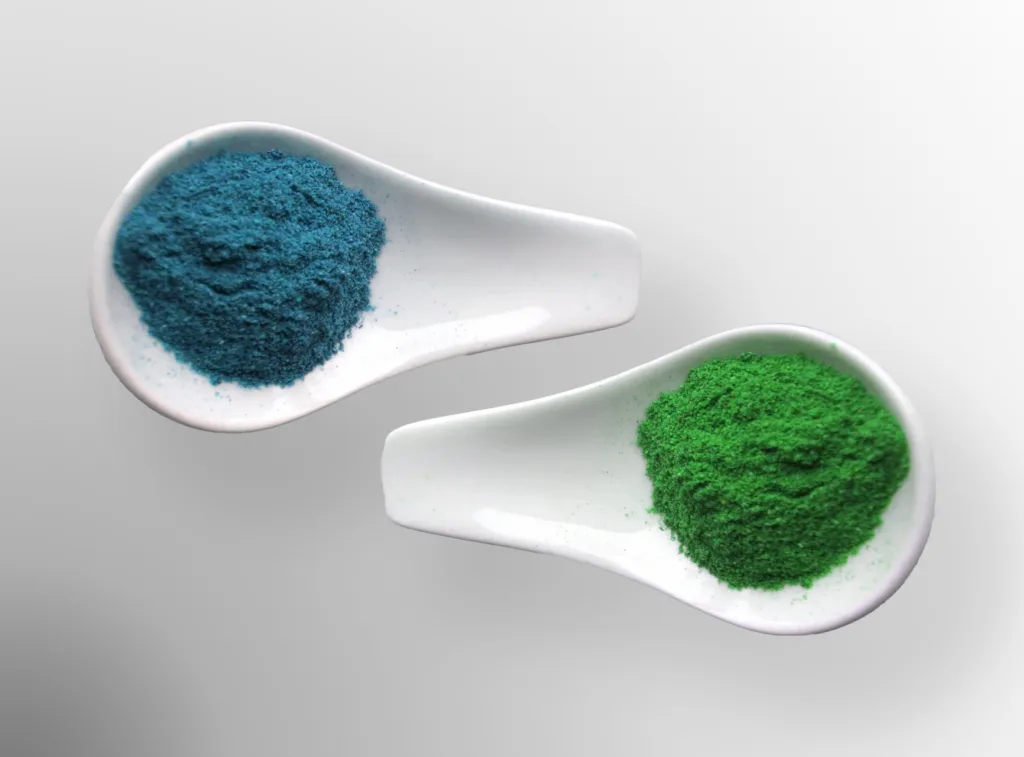
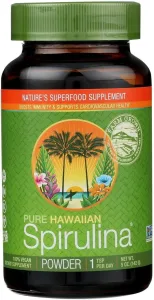

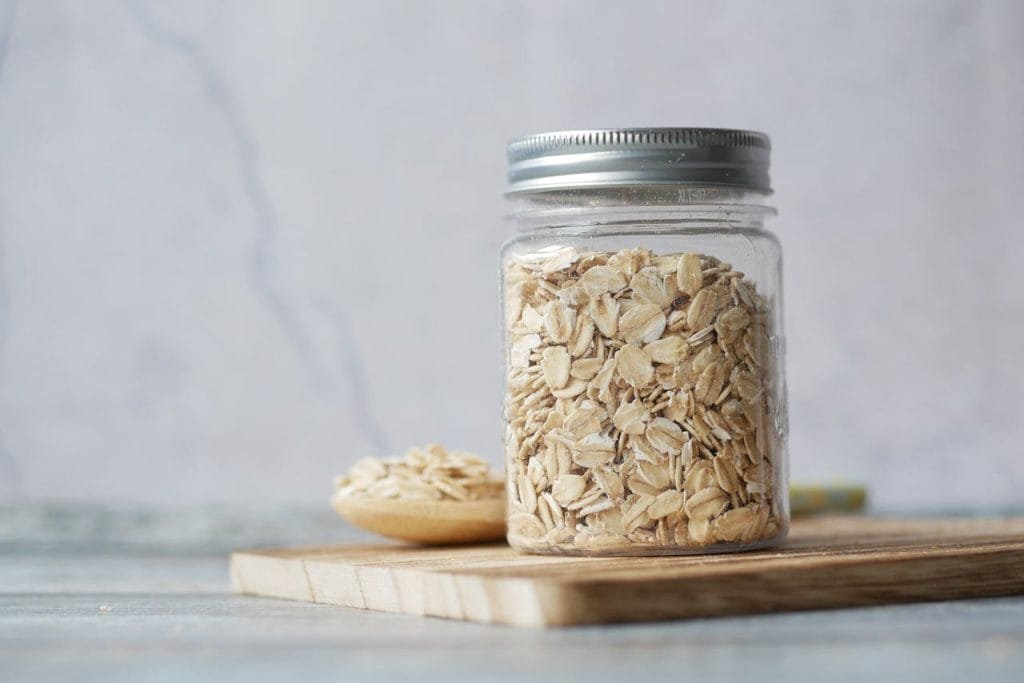


I really enjoyed reading this. Thanks for the clear explanation!
Glad you like it 🙂